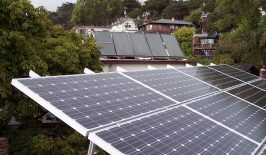Redox flow batteries are not entirely new, the basics of the technology were already developed in the middle of the 20th century at the Technical University Braunschweig: Two different liquid electrolytes are stored in separate tanks for the positive and negative electrode sides. In the so-called “stack”, an energy converter between the tanks, the liquid can then circulate through two half cells, where an electrochemical reaction to charge or discharge takes place.
CMBlu Energy AG took up this concept in 2014, but with one important difference: Their solution does away with the heavy metals and rare earths normally required for the process to work. Instead, organic electrolytes from lignin – a chemical compound contained in plants to give them stability – is used. But how did the company in Lower Franconia decide to use lignin to store energy?
Inspired by the Human Brain
The founder of CMBlu, Dr. Peter Geigle, is himself a physician and has been working on the energy supply of brain cells for decades. The conversion of food into energy in the body is also a redox editing process based on organic ring molecules. These ring molecules are able to absorb, store and release energy when required. The basic idea of CMBlu was to simulate this biological process – with electricity.
“Lignin quickly emerged as a potential resource because it contains many ring molecules and has not yet been used industrially,” explains Stefan von Westberg of CMBlu to RESET.
In cellulose and paper production alone, more than 50 million tons of lignin are produced as a waste product every year and are almost exclusively incinerated because they are not used for their intended purpose. According to von Westberg, the CMBlu energy storage solution does not (initially) even require the planting of additional trees: “After all, the use of a wood waste product also drastically reduces costs, so that one can stay well below the current market prices for large energy storage systems.”
In addition, lignin can be completely recycled at the end of its service life, thus ensuring a naturally renewable and permanently available source for large-scale energy storage.
Another advantage, according to the company, is the independent scalability of the technology. Thanks to its modular design, it is theoretically possible to build energy storage devices of any size. To achieve this, only the number of stacks has to be increased – and entire regions can be supplied with electricity safely and sustainably.
Organic Batteries for the Energy Revolution?
Organic-flow batteries have the potential to act as large-scale energy storage systems from 100 kW, so the technology could be used primarily for large stationary power storage systems – for example as failure protection, peak load buffers in industrial plants but also as part of a wider energy revolution. Although the technology is not suitable for storing electricity for a single household, it could be conceivable to create joint storage facilities for larger groups of homes. The batteries would also not be suitable for electric vehicles, where weight and space are essential, as they have a lower energy density than conventional lithium-ion batteries. According to CMBlu, however, for the charging infrastructure outside the vehicles they are excellently suited to provide high performance even without grid expansion.
The Alzenau-based company’s organic redox flow batteries are currently in the prototype development phase. And CMBlu is working together with universities in Gießen and Mainz as well as with industrial partners. According to von Westberg, the first prototypes will be delivered to selected pilot customers as early as next year, with the market launch planned for 2021. Until then, some challenges still have to be overcome. According to CMBlu, the biggest hurdle for development is the high cost of capital for the industrialisation of energy storage and the achievement of mass production. There are also regulatory challenges which depend on national laws and may restrict the development and market access of storage systems in some countries.
Only after the market launch will it become clear how great the potential of organic flow batteries actually is. However, if the technology delivers what CMBlue promises in terms of sustainability and energy efficiency, it could have a decisive impact on the positive, sustainable transformation of our energy system.
This is a translation by Mark Newton of an original article that first appeared on RESET’s German-language site.






